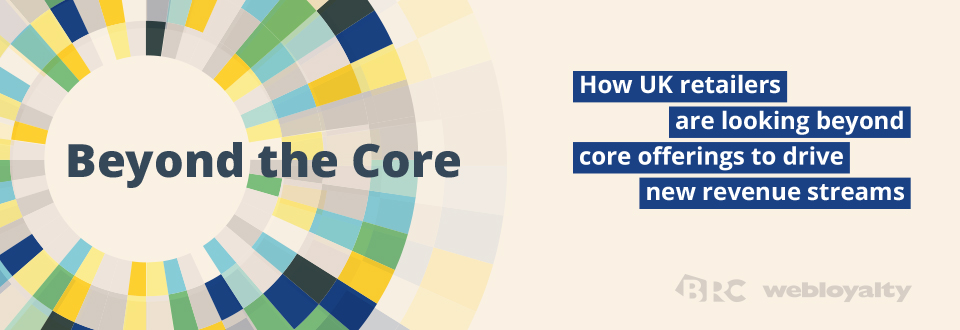The internet has been the source of both destruction and creation for retail. While signalling the end for many traditional brick-and-mortar stores, unable or unwilling to keep pace with the digital revolution, the internet has also brought about the rise of ecommerce, where consumers can enjoy increased choice and retailers are able to compete for a share of the larger market.
In this the online environment, profit margins are squeezed and retailers are stretched. With such a large playing field, each sale is more valuable than ever before.
This is why secondary sources of revenue are vital to the long-term health of any retailer. As Webloyalty’s report, Beyond the Core: How UK Retailers are Looking Beyond Core Offerings to Drive New Revenue Streams shows, successful businesses are those that spread income across several revenue streams. According to the report, “amongst businesses with turnover of less than £1m, only 8% are generating more than 20% of their revenue from secondary sources, compared to 22% of those businesses with a turnover greater than £1m.”
One of those major sources of secondary revenue is affiliate programming.
Monetising Matters
Pierpaolo Zollo, VP of Business Development at restaurant table-booking website Quandoo, explains the nature of this potential revenue source: “Affiliate programmes provide a monetisation solution for publishers of any type of content – this could be classified sites, blogs, or portals – and the aim for retailers is that it will deliver a secondary revenue stream alongside their core business.”
“The simplest solution involves a widget that displays offers from retailers or providers of services through a banner ad that is simply added to a publishers’ site using a cut-and-paste type process,” continues Zollo. “The banner could in theory involve an offer on any product.”
The idea is straightforward. When a customer clicks on the banner ad, they are directed to an online retailer selling a product. If the consumer buys the product, the affiliate – the site, blog, or individual who shows the banners – is paid a small amount by the retailer. There is also a fee for the affiliate service provider. It is a beneficial agreement for all parties.
Building Blocks
Once a crude plaoy, affiliation is becoming increasingly complex and insightful. Each banner or offer a web user sees has been created especially for the specific internet user seeing it, based on their personal browsing history and the data websites have already collected. No two banners will be the same.
“Even the simplest of banners have become much more sophisticated and can now use programmatic capabilities to enable publishers to determine the pricing of offers, and AI has also become very relevant”, Zollo explains.
While poor affiliation is detrimental to ecommerce retailers – “customers don’t want to leave pages because of the annoyance of irrelevant affiliate” – the improved ability of affiliate programmes to focus directly on individuals provides one of the strongest antidotes to consumer disloyalty. Being able to repeatedly offer a consumer items associated with their interests is a powerful tool and one that ecommerce retailers should not ignore.
It is also one of the principles Webloyalty identified to be key in developing a sound secondary revenue strategy, the need to “introduce relevant offers at the right stage of the customer journey.”
Sharpening the Tools
Considering that 20% of consumers aged between 25 – 34 and 18% aged between 35 – 44 identify themselves as Personalisation Motivated Shoppers, affiliate programmes have a clear and friendly market which will become stronger in the coming years. “There is a massive opportunity to improve revenue”, says Zollo.
For retailers that are considering affiliate programmes, he has some advice.
“Data and data analysis is critical,” Zollo explains. “The type of technology used differs between the various affiliate providers. Go for a more sophisticated product to ensure the customer only receives relevant content. There has to be the right balance of transaction business versus being cautious and not alienating the customer.”
When any help in getting ahead of the competition is welcome, the use of affiliate programmes is a secondary revenue strategy that any retailer should be considering.
Beyond the Core
Webloyalty has partnered with the BRC to publish our first Beyond the Core research report, a study into how UK retailers are looking beyond core offerings to drive new revenue streams. The report provides valuable insight into the application of secondary revenue generation amongst UK retailers.

